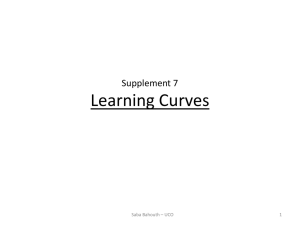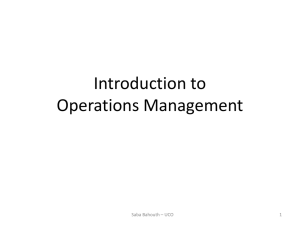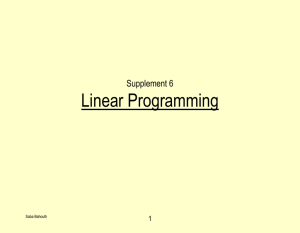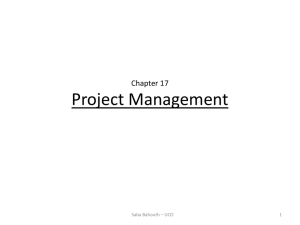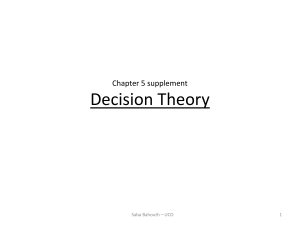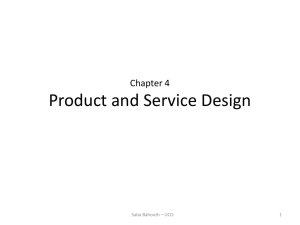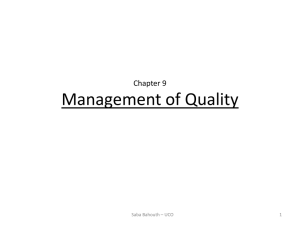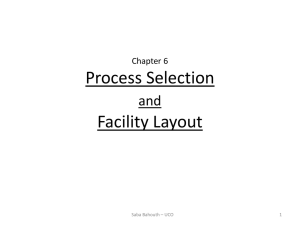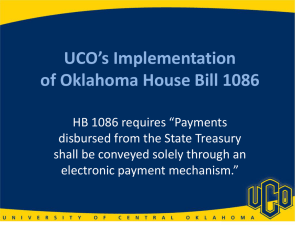Chapter 5
advertisement
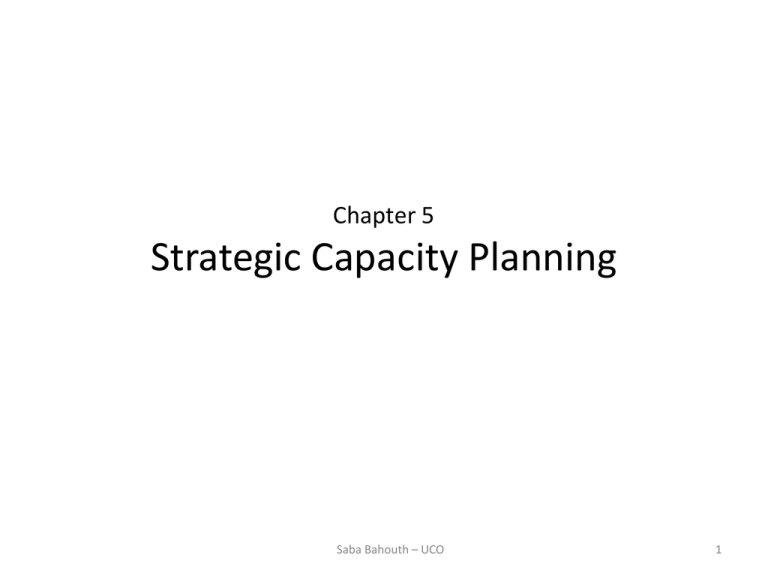
Chapter 5 Strategic Capacity Planning Saba Bahouth – UCO 1 Sputnik Saba Bahouth – UCO 2 Capacity Planning • Capacity is the upper limit or ceiling on the load that an operating unit can handle. • The basic questions in capacity handling are: – – – What kind of capacity is needed? How much is needed? When is it needed? Saba Bahouth – UCO 3 In-House or Outsourcing Outsource: obtain a good or service from an external provider 1. 2. 3. 4. 5. 6. Available capacity Expertise Quality considerations Nature of demand Cost Risk Saba Bahouth – UCO 4 Types of Capacity Planning Over Time Horizon Long Range Planning Add Facilities Add equipment * Intermediate Range Planning Sub-Contract Add Equipment Add Shifts Add Personnel Build or Use Inventory Short Range Planning *Limited options * Modify Capacity Saba Bahouth – UCO Schedule Jobs Schedule Personnel Allocate Machinery Manage with existing Capacity 5 Definitions and Measurements Capacity: The “throughput,” or number of units a facility can hold, receive, store, or produce in a period of time. Design Capacity: Maximum theoretical output Effective Capacity: Capacity a firm can expect to receive given its product mix, methods of scheduling, maintenance, scrap, personal time. Actual Output: What is actually being produced, in units. Efficiency: Actual Output / Effective Capacity (Actual Output in units / Standard Output in units) Utilization: Actual Output / Design Capacity (Hours used / Total hours available) Saba Bahouth – UCO 6 Simple Example A dentist assistant schedules a patient every 10 minutes. This dentist treated 40 patients today. The dentist works 8 hours a day. The office is set up to handle a maximum of 60 patients a day. What is the efficiency of this dentist office? What is the utilizations of this dentist office? Saba Bahouth – UCO 7 Special Requirements for Making Good Capacity Decisions • Forecasting demand accurately – Cycles; overestimating growth; seasons; complementary products • Building for change • Understanding capacity increments • Finding the optimal operating level (volume) Saba Bahouth – UCO 8 Understanding Capacity Increments Expected Demand Expected Demand New Capacity Demand Demand New Capacity Time in Years Capacity leads demand with an incremental expansion Time in Years Capacity leads demand with a one-step expansion Expected Demand New Capacity New Capacity Demand Demand Expected Demand Time in Years Capacity lags demand with an incremental expansion Saba Bahouth – UCO Time in Years Attempts to have an average capacity, with an incremental expansion 9 Cost per unit Economies of Scale 0 Small plant Medium plant Large plant Output rate Saba Bahouth – UCO 10 Tools for Capacity Decisions 1. Break-even Analysis Single-product case Break-even in units: Total Fixed Cost Price Variable Cost Total Fixed Cost Break-even in Dollar Sales: 1 Variable Cost Price 2. Decision Theory Decision Making Tools 3. Financial Analysis Net Present Value (NPV): NPV F ( i 1) N 4. Queueing / Waiting lines (Simulation) Saba Bahouth – UCO Amount ($) Cost-Volume Relationships 0 BEP (Quantity in units) Saba Bahouth – UCO 12 Crossover Chart Process A: low volume, high variety Process B: Repetitive Process C: High volume, low variety Cost Fixed cost - Process C Fixed cost - Process B Fixed cost - Process A Process A Process B Process C Saba Bahouth – UCO Quantity 13 Break-Even Problem with Step Fixed Costs $ Revenues TC 1 machine 2 machines 3 machines Quantity Saba Bahouth – UCO 14 Assumptions of Cost-Volume Analysis 1. 2. 3. 4. 5. 6. One product is involved Everything produced can be sold Variable cost per unit is the same regardless of volume Fixed costs do not change with volume Revenue per unit constant with volume Revenue per unit exceeds variable cost per unit Saba Bahouth – UCO 15 Managing Existing Capacity Demand Management Capacity Management • Vary prices • Vary promotion • Change lead times (e.g., backorders) • Offer complementary products • Vary staffing • Change equipment & processes • Change methods • Redesign the product for faster processing Saba Bahouth – UCO 16 Planning Service Capacity • Need to be near customers – Capacity and location are closely tied • Inability to store services – Capacity must be matched with timing of demand • Degree of volatility of demand – Peak demand periods Saba Bahouth – UCO 17
